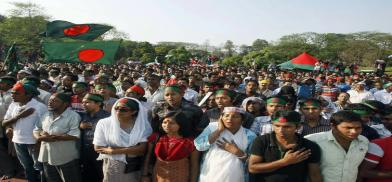Like its remarkable economic turnaround, Bangladesh has fought back against Islamist extremism
Fifty years after its liberation from Pakistan, Bangladesh is the reverse image of the country it broke away from -- a moderate Muslim majority nation anchored in its liberal syncretic Bengali culture that guided its 1971 secession from Pakistan, writes Subir Bhaumik for South Asia Monitor

The July 1, 2016 terror attack on a Dhaka upscale restaurant marked the climax of a radical Islamist violent campaign in Bangladesh, in which scores of secular publishers, bloggers, writers and even folk singers were systematically eliminated. The restaurant attack, which left 22 diners, including 18 foreigners, dead sent shockwaves through Bangladesh and elsewhere because the violent campaign was strongly complemented by the BNP-Jamaat-e-Islami combine’s inspired street violence aiming to topple the Prime Minister Sheikh Hasina's Awami League government which radicals berate as ‘murtad’ (apostate).
Many felt Bangladesh was falling apart, headed for a counter-revolution, and even saw it as a new Afghanistan. But Prime Minister Sheikh Hasina’s government fought back against these radicals with as much determination as it displayed in its pursuit of economic growth.
Within three months after the murderous July 1 terror strike, the top guns of Islamist militancy were eliminated.
Between July-September 2016, the Bangladesh security forces first killed Raihan Kabir, who had trained the July 1 attackers, and eight of his associates, then eliminated Tamim Ahmed Chowdhury, chief of the ‘neo-JMB’ with two close lieutenants and finally shot dead neo-JMB’s northern region commander Khalid Hassan alias Badar Mama and its military wing chief former army major Zahidul Islam.
Tanvir Qaderi, who had taken charge of the neo-JMB faction after Tamim Chowdury’s death, was also killed in September 2016.
The Canadian-Bangladeshi Tamim Ahmed Chowdhury had become the poster boy of the post-2013 jihad in Bangladesh. His hardline JMB faction (described as ‘neo-JMB’) became the ISIS flag-bearer in Bangladesh and his fighters sported Arab headgear and held up the ISIS flag during the July 1 strike.
Restoring investor confidence
But the fierce crackdown continued alongside PM Hasina's policy of "harmonious co-existence between secularism and Islam". Based on Hasina's "zero-tolerance to terror", Bangladesh's robust counter-terrorism profile elicited praise from both India and the West.
Investor confidence, shaken by the July 1, 2016 terror strike, has been largely restored. Japan, worried after losing six of its citizens in that attack, has continued all its development infrastructure projects, including the Dhaka Underground Rail and the Matarbari deep seaport.
All other development partners including India and China have continued funding major infrastructure projects.
A former Federal Bureau of Investigation (FBI) counter-terrorism chief praised Bangladesh security forces for doing a "commendable job" in fighting terror, despite the occasional allegations of excesses.
He attributed the success to tough basic policing, improved intelligence cooperation with Indian and Western agencies and an economic boom that left few youths jobless. Hasina's policy of striking bigheads and wooing back the foot-soldiers, he said, has worked.
By preventing an Islamist takeover, Bangladesh managed to retain global confidence in its hardworking labor force. No wonder, foreign remittances surged to become the nation’s second-largest foreign exchange source after garments, fuelling an unprecedented economic boom.
Meeting Hifazat challenge
But the Islamist challenge has not ended. Two years ago, the radical Hifazat-e-Islam started a series of “burn-all, wreck-all” street agitation, with full support from BNP and Jamaat-e-Islami.
The Hifazat first opposed the installation of statues of the country’s founding father and first president Sheikh Mujibur Rahman on grounds they were un-Islamic, then protested furiously against France's anti-Islamist crackdown, and finally, they tried stopping Indian PM Modi's visit to Bangladesh on the Golden Jubilee of Bangladesh’s independence.
But the strike back against Hifazat has also been as determined as the previous one against the terror groups. More than 60 Hifazat leaders including their poster boy Mamunul Huq have been arrested and now face a host of criminal charges. Their external funding has been all but choked.
The ruling Awami League has joined the battle for hearts and minds against the radicals, exposing Pakistan-style child abuse in Hifazat-run madrassas, their unaccounted wealth and rampant womanizing.
Glorifying terror victims as heroes
Two victims of the July 1 terror strike, who stood up to the radicals in Arab headgear, have been glorified as national heroes while the radicals were written off as "immature, gullible villains".
Dhaka Art Gallery owner Ishrat Akhound Nila yelled at the terrorists when challenged why she was not wearing the hijab as a Muslim. "We did not liberate this country to put on hijab," were her last words before she was shot dead.
Faraaz Hossain, the grandson of Bangladesh's media magnate Latifur Rahman, died fighting with bare hands as he tried to save his two female friends, one an Indian Hindu.
Nila and Faraaz were seen defending the very liberal Bengali values, for which tens of thousands had fought and embraced death against Pakistan's army in 1971. The radicals lost both the perception battle and the one on the streets.
In 2013, Bangladesh's actress-lawyer politician Tarana Halim led a protest march to the Pakistan embassy in Dhaka in support of the government's 1971 War Crimes trials. Pakistan's opposition to these trials had provoked the march.
"Amar Mati, Amar Ma, Pakistan Hobe Na" (my mother, my soil will never be Pakistan) was the slogan Halim, later junior information minister, raised.
Fifty years after its liberation from Pakistan, Bangladesh is the reverse image of the country it broke away from -- a moderate Muslim majority nation anchored in its liberal syncretic Bengali culture that guided its 1971 secession from Pakistan and relentless in its push for economic development that makes it South Asia's latest economic bull.
(The writer, a former BBC and Reuters correspondent, has authored five books on Northeast India and its neighborhood. The views expressed are personal. He can be contacted at sbhaum@gmail.com)









Post a Comment